Explore a static GUI prototype demonstrating the CrossContext UX Design vision here:
https://cross-context-ux-demo.kryzhnii.me
This prototype illustrates core concepts like the UI structure, the block model, and cross-context referencing.
Please keep in mind: It's a non-interactive visual demo; data cannot be modified, and AI features are simulated for illustrative purposes only. It represents a design direction, not a finished product.
Table of Contents
- 1. The Bottleneck: Why Working with AI Feels... Clumsy
- 2. The Fragmentation Frustration
- 3. Introducing CrossContext: A Vision for Unified AI Interaction
- 4. How It Works: Restaurant App Development Example
- 5. Simple Use Cases, Big Impact
- 6. The Road Ahead: Building the Future of CrossContext
- 7. Join Us: Help End Fragmented AI
1. The Bottleneck: Why Working with AI Feels... Clumsy
Is your AI assistant truly assisting, or just adding to your copy-paste workload? We live in an age of powerful AI, yet interacting with it often feels fragmented and inefficient.
Consider the common workflow: finding insights online, copying to notes, pasting into a chatbot for summary, copying that summary to an email or project doc. Each step is a manual transfer across isolated application silos. This isn't just tedious; it's a fundamental bottleneck. This constant context-switching stifles creative connections, obscures the bigger picture, and limits the potential for deep insight. We're forced to be the human glue, losing valuable time and mental energy just managing information flow.
This fragmentation prevents AI from becoming a true cognitive partner. What if our tools could inherently understand the links between ideas, research, and conversations? What if AI could access and reason across these connections seamlessly?
This is the vision behind CrossContext: a user experience (UX) design fundamentally rethinking how we interact with AI and manage information. It's not just about a new tool, but about the necessary evolution towards truly integrated intelligence, moving beyond fragmented tasks to fluid, context-aware collaboration with AI. This post introduces the core ideas and the early-stage prototype that illustrates this direction.
2. The Fragmentation Frustration
The core challenge CrossContext addresses is fragmentation. Here's why it matters:
- Siloed Applications: Most tools (AI chatbots, note apps, project managers) keep information trapped within their own boundaries. Connecting insights requires manual effort.
- The "Copy-Paste" Burden: Constantly moving data between apps is time-consuming, error-prone, and breaks concentration.
- Lost Context: AI needs context to be truly helpful. When information is scattered, the AI operates with blinders on, leading to less relevant results.
- Reduced AI Potential: Fragmentation limits what AI can do for us. We're not tapping into its full collaborative power because our tools can't talk to each other effectively.
3. Introducing CrossContext: A Vision for Unified AI Interaction
CrossContext tackles fragmentation head-on by providing a unified, context-aware environment. It's designed not just as another application, but as a fundamental shift in how we organize, connect, and process information with AI assistance. The goal is to create a space where your ideas, research, and AI interactions converge naturally.
3.1. The Power of Connected Context
The central idea is enabling cross-context interaction. Instead of isolated files or notes, CrossContext allows you to build a dynamic network of knowledge. You can seamlessly link related pieces of information, reference insights from one project while working on another, and provide AI tools with the rich, interconnected context they need to excel. The goal is to make working between different contexts as easy as working within one.
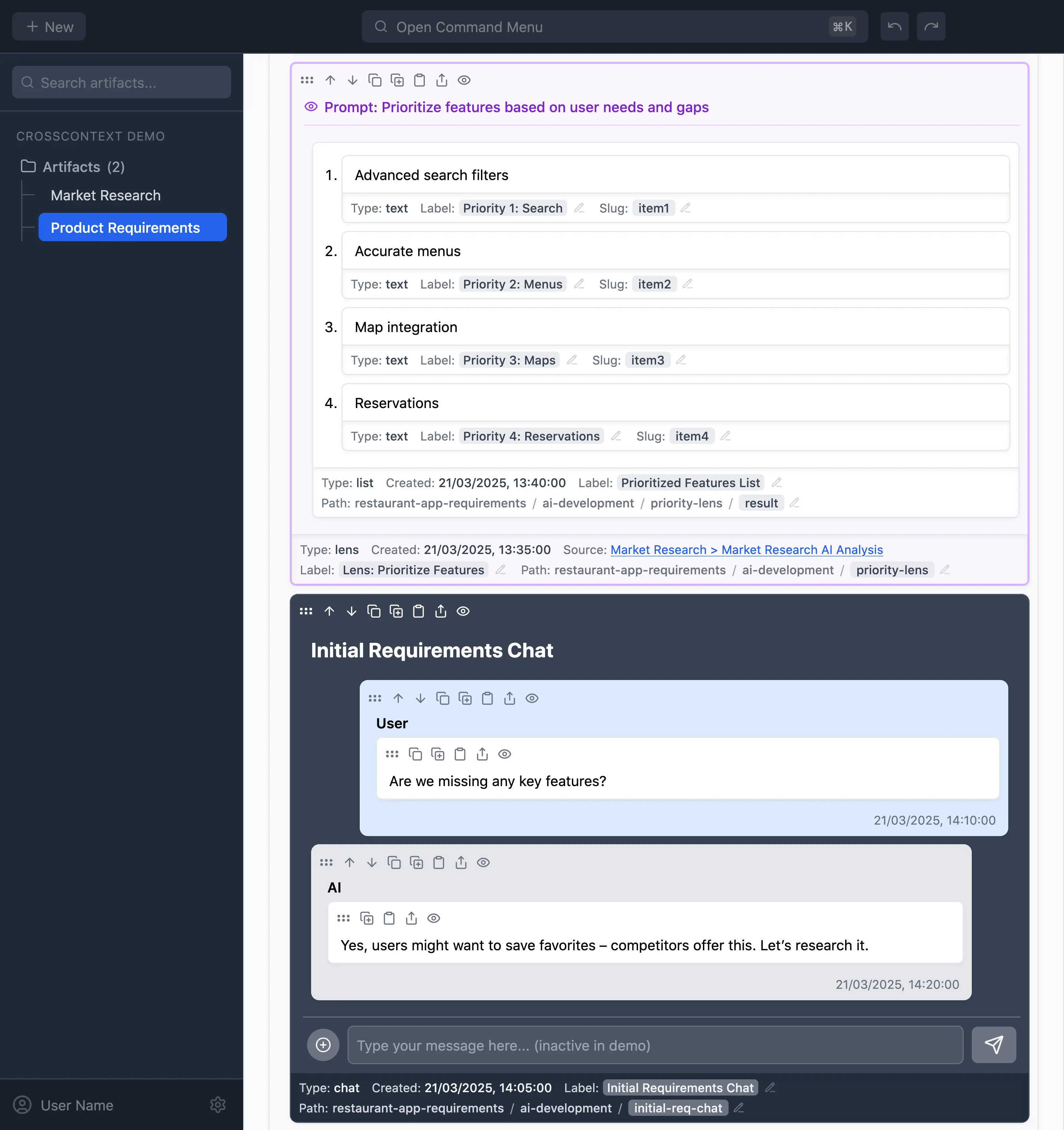
3.2. Core Design Concepts
CrossContext achieves this unification through a few key design concepts illustrated in the static prototype:
3.2.1. Artifacts: Your Focused Workspaces
An Artifact is a top-level container representing a distinct context – a project, a research topic, a meeting, a specific goal. It's more than a folder; it's visualized as an active workspace where you create, connect, and utilize information.
3.2.2. The Block Model: Granular, Connected Information
Within each Artifact, information is structured using Blocks. These fundamental units can be anything from a paragraph, heading, or list item to an image or an AI-generated summary. Importantly, they also encompass entire AI chat conversations (chat blocks), which contain individual chat message blocks. You can even embed multiple, distinct chat sessions within a single Artifact, keeping discussions organized and contextually relevant. This granular, block-based approach is fundamental to enabling the fine-grained referencing and structured AI interaction that CrossContext provides. It allows for:
- Fine-grained referencing: Link directly to a specific paragraph or data point within or across Artifacts.
- Modularity: Easily reuse and recombine information.
- Structured AI Interaction: AI can operate on specific blocks, understanding their role within the larger context.
Managing information as interconnected data blocks, each with its own unique identifier, is key to the CrossContext approach.
3.2.3. Addressing Blocks: Labels, Paths, and Slugs
Managing potentially thousands of blocks across many Artifacts requires a clear and robust way to identify and navigate them. Simple sequential IDs aren't enough. CrossContext introduces a multi-faceted approach, visible in the UI prototype:
- Editable Label: Each block has a primary, human-readable Label (like "Yelp Strengths" in the screenshot). This is the main title you interact with, and it's easily editable. AI can even assist in suggesting relevant labels.
- Hierarchical Path (Breadcrumbs): To understand where a block lives, a Hierarchical Path is displayed, often resembling breadcrumbs (e.g.,
restaurant-app-market-research / competitor-analysis / yelp / strengths). This path shows the nesting structure within the Artifact, providing valuable context and aiding navigation. - Editable Slug: The last segment of the Hierarchical Path is the block's Slug (like
strengths). While initially derived from the Label, this slug is also directly editable by the user (indicated by the pencil icon). This allows for concise, meaningful path components that are stable even if the main Label changes, and can also be AI-suggested for consistency. - (Under the Hood: GUID): While less visible, each block also has a unique, immutable global ID (GUID). This ensures that even if a block is moved or its label/slug is changed, any links pointing directly to it remain stable and unbroken.
This system provides multiple layers of identification: a user-friendly Label for display, a contextual Path for navigation and understanding structure, a customizable Slug for refining the path, and a rock-solid GUID for reliable linking.
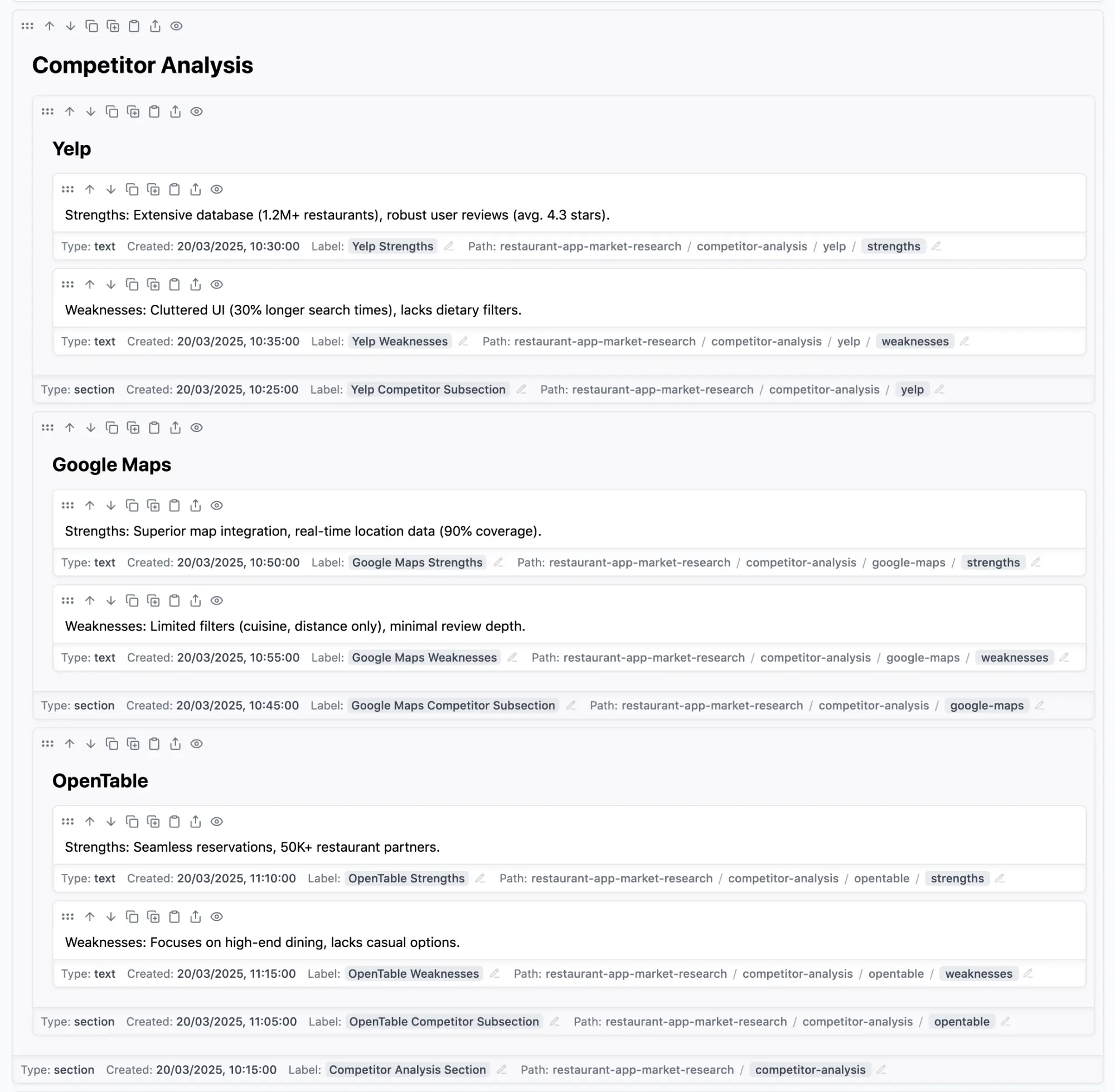
3.2.4. Lens Frames: Your AI-Powered Insight Engine
Lens Frames are a unique CrossContext feature, visualized in the prototype. They are special Blocks designed to provide dynamic, AI-processed views of other Blocks or even entire Artifacts (their sources).
- How they work (Concept): You select source(s) and provide a prompt (e.g., "Summarize key findings," "Extract action items," "Identify sentiment").
- AI Integration (Concept): The Lens Frame uses an AI model (like GPT-4, Claude 3, etc. - simulated in prototype) to process the source content based on your prompt.
- Dynamic View (Concept): The result is displayed within the Lens Frame. A key future goal is Lens Frame Data Reactivity, where the Lens Frame automatically updates its view if the source information changes.
Lens Frames allow you to synthesize information, extract insights, and automate analysis without manual copy-pasting, conceptually keeping the connection to the original data intact.
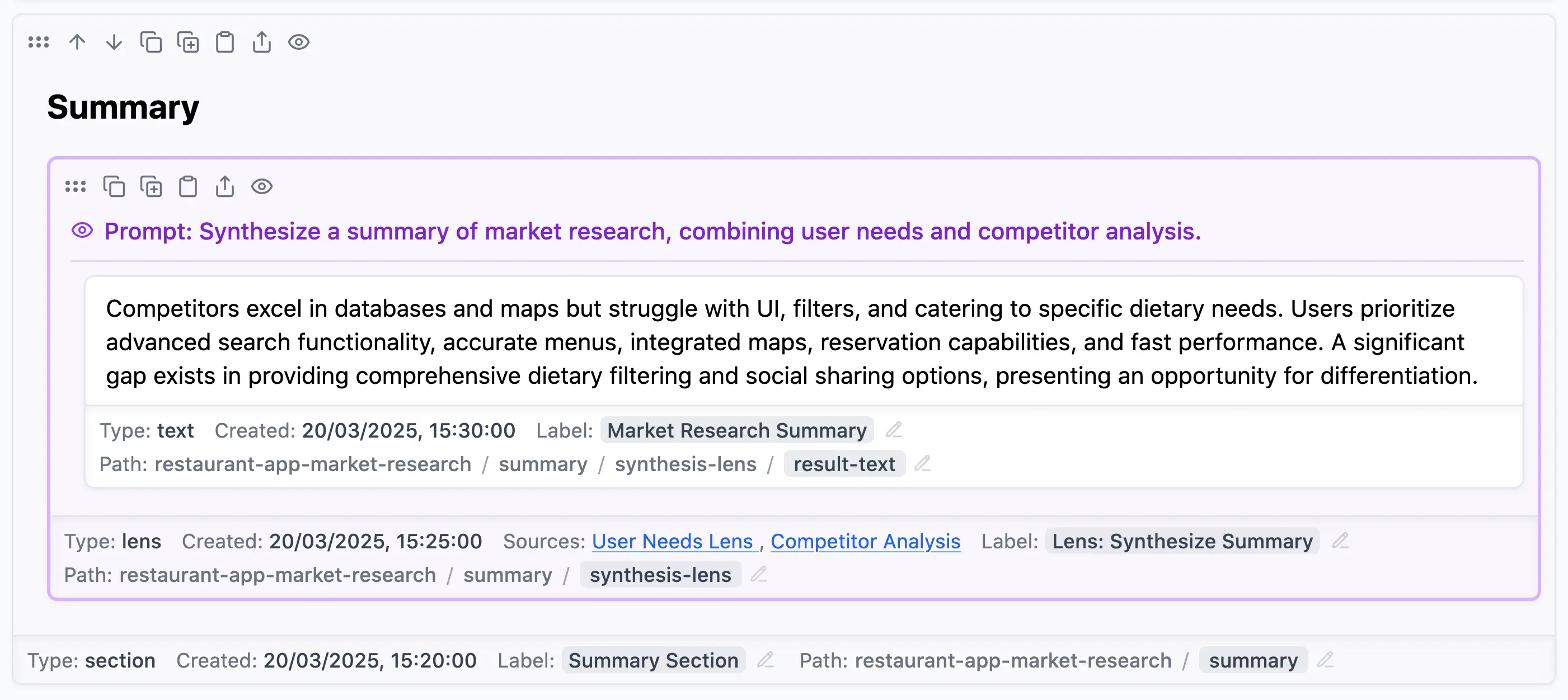
4. How It Works: Restaurant App Development Example
To illustrate the CrossContext design vision, let's consider a simplified example: a development team building a mobile app for discovering local restaurants. They face the common challenge of connecting market research insights with product requirements.
(Note: The following describes the intended workflow facilitated by CrossContext design principles, as illustrated conceptually in the prototype.)
4.1. From Research Insight to Product Requirement
The team gathers user feedback ("Need vegan options!") and competitor data in their "Market Research" Artifact. Using Blocks, they organize this raw data.
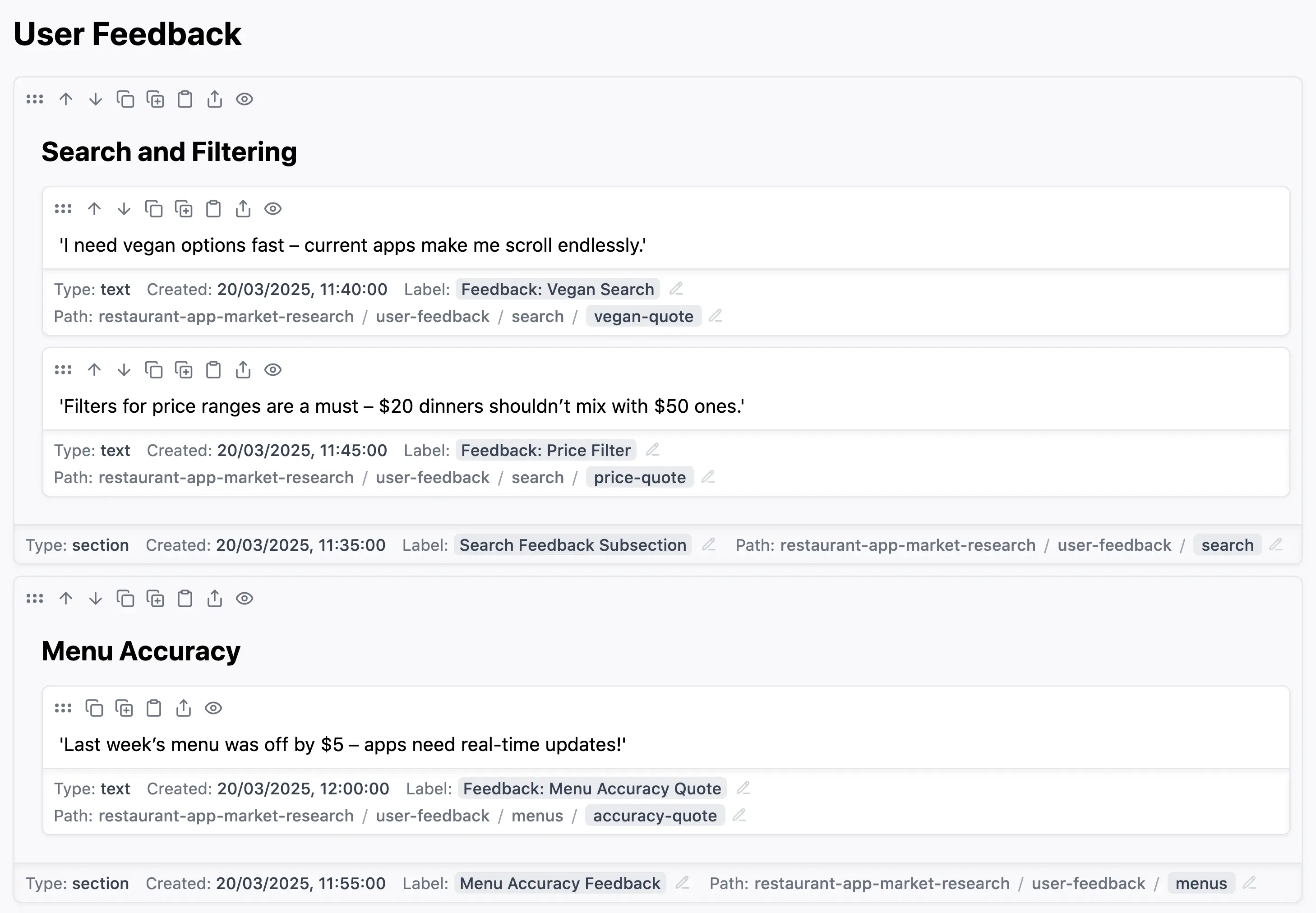
In their "Product Requirements" Artifact, while defining the "Advanced Search" feature for their restaurant discovery mobile app, instead of merely writing descriptive text, they create a Reference Block establishing a connection directly to the specific "vegan options" feedback Block in the Market Research Artifact. This direct link clearly shows why the feature is needed, grounding the requirement in specific user feedback.
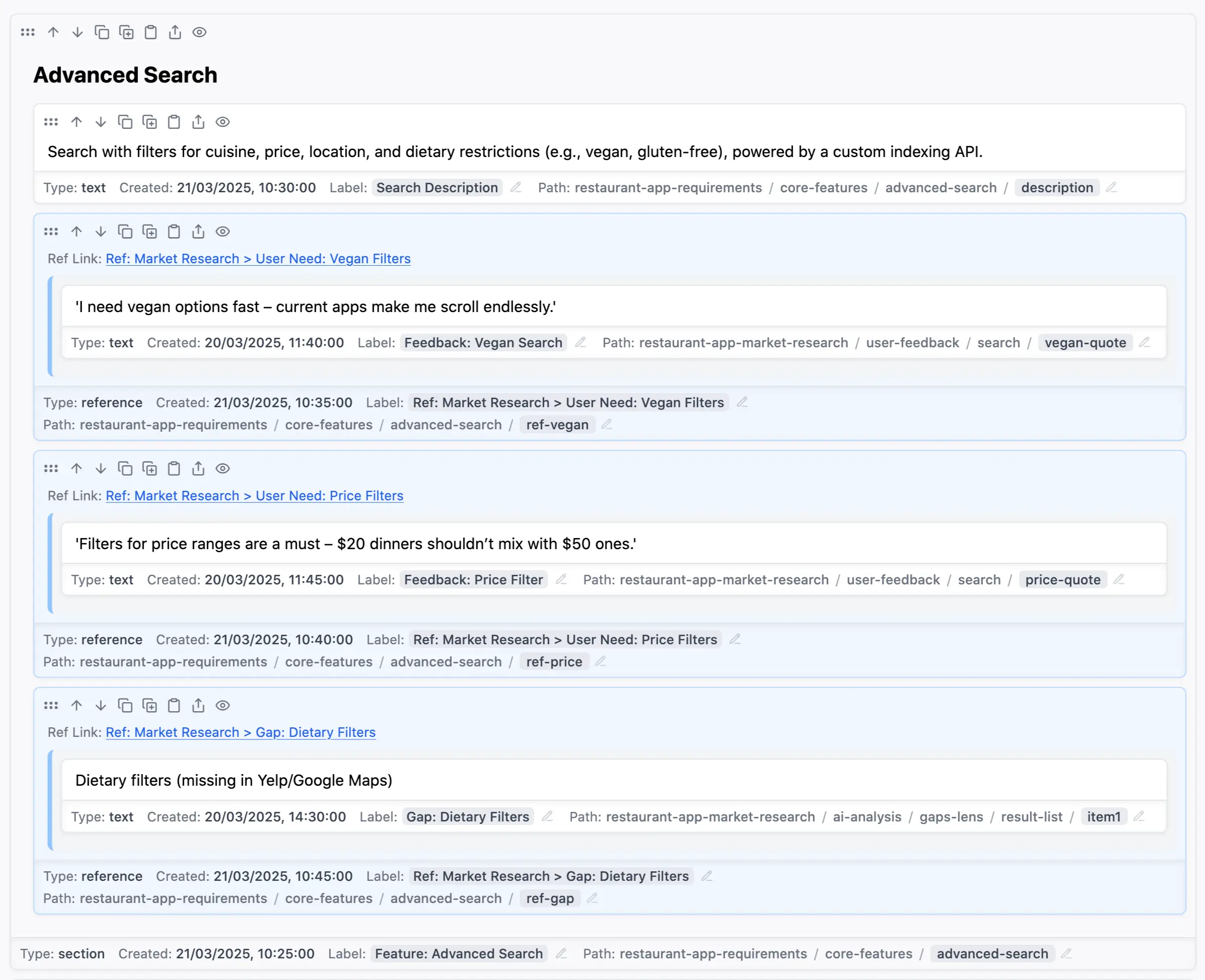
4.2. AI as a Collaborative Partner
The team uses Lens Frames conceptually:
- To summarize all competitor weaknesses.
- To extract key user needs from feedback comments.
- To identify gaps between user needs and competitor features.
They also use integrated Chat Blocks. When discussing the mobile app's "Save Favorites" feature, the AI (simulated) suggests researching competitors. The team starts a new "Favorites Research Chat" within the Market Research Artifact, linking it back to the original discussion Block in Product Requirements. The research findings (also Blocks) are then linked back to the final "Save Favorites" feature requirement. In this design, AI isn't just a separate tool; it's a participant woven into the knowledge fabric.
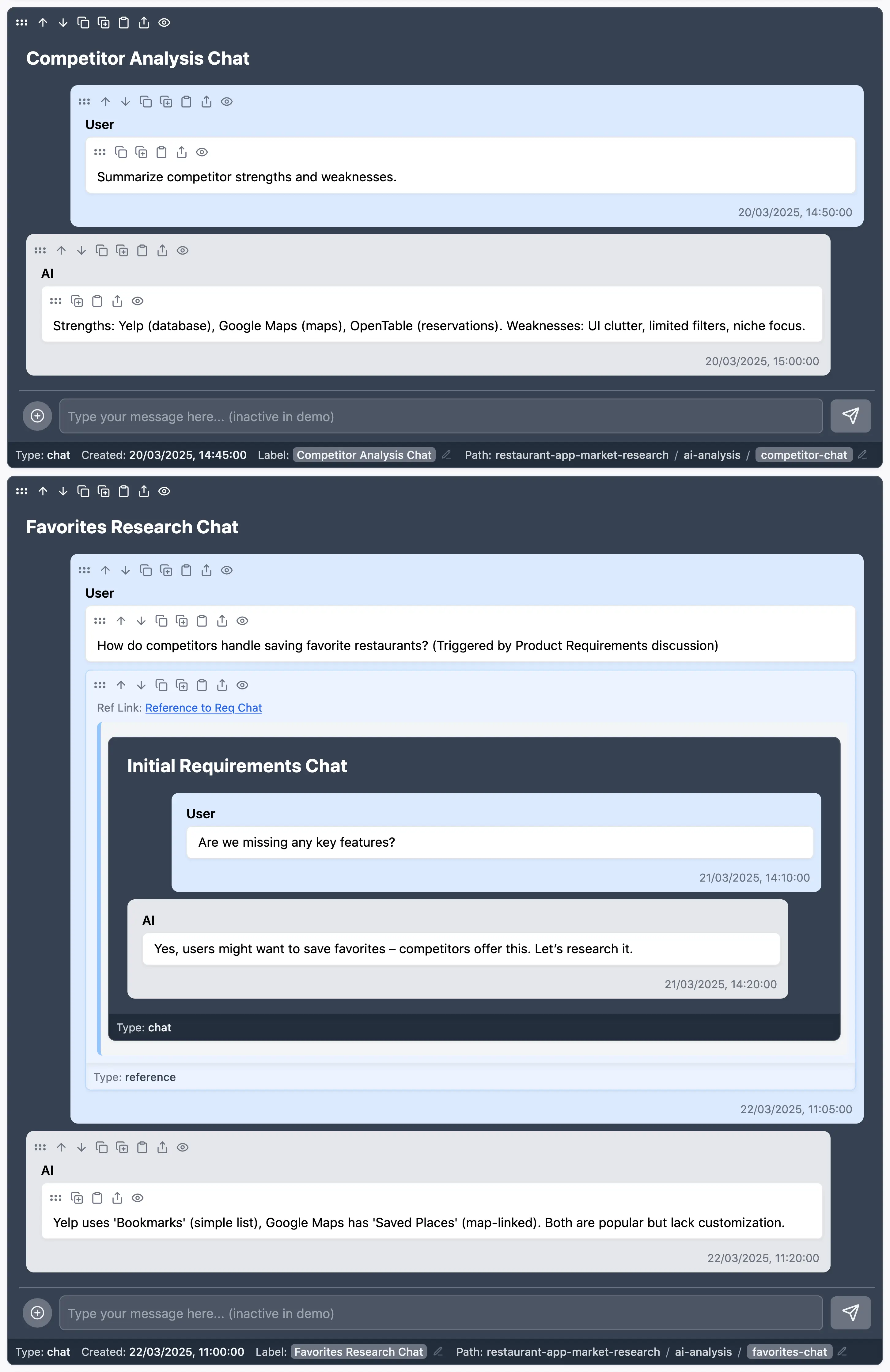
This intended seamless flow – linking research to requirements, using AI for analysis, tracking discussions – aims to eliminate fragmentation and ensure everyone works with the same connected understanding.
5. Simple Use Cases, Big Impact
While the restaurant app example shows a potential complex workflow, CrossContext's design principles aim to simplify everyday tasks:
- Building a Knowledge Base: Create Artifacts for different topics. Use Blocks for notes and summaries. Link related concepts across Artifacts using Reference Blocks. Use Lens Frames to create dynamic summaries.
- Meeting Summarization: Have an Artifact for a project meeting. Use Chat Blocks for the discussion. Use a Lens Frame with a prompt like "Extract action items" to automatically generate a task list Block, linked back to the relevant discussion points.
- Academic Research: Organize papers in different Artifacts. Use Blocks for annotations and quotes. Link related ideas across papers. Use Lens Frames to synthesize literature reviews.
The core benefit remains the same: designing a system to keep information connected and contextually accessible for both humans and AI.
6. The Road Ahead: Building the Future of CrossContext
The static prototype you can explore today is an early illustration of the CrossContext UX design philosophy. It's a foundational step. CrossContext is envisioned as a dynamic, open-source platform designed to evolve based on this vision. Our roadmap focuses on bringing these design principles to life in a functional application. We believe this project has the potential to become a foundational piece of the future AI-powered workspace.
6.1. Key Future Directions
Our vision for CrossContext extends far beyond the current prototype. We aim to build a comprehensive, interconnected workspace. Key strategic themes guiding future development include:
-
Evolving into a Collaborative Knowledge Hub: We see CrossContext growing into a powerful platform for team collaboration, akin to a next-generation, AI-enhanced wiki. This involves implementing real-time and asynchronous collaborative editing, robust multi-user management, and Git-like versioning/branching for artifacts and blocks, all supported by a reliable synchronization architecture. We aim to foster shared understanding and enable seamless teamwork, all within a single, unified context.
-
Deepening AI Integration & Intelligence: Core to the vision is weaving AI more deeply into the fabric of work. This means supporting diverse LLMs (cloud and local), integrating advanced capabilities like multi-modal understanding (vision, image generation), leveraging protocols like MCP, and developing a powerful backend architecture for sophisticated chat features and agentic capabilities. We also plan features like Lens Frame reactivity, an integrated AI Voice Assistant (with potential mobile client), and enhanced semantic search to make finding and understanding information effortless.
-
Enhancing Content Creation & Data Handling: Creating and managing information needs to be fluid. While rich WYSIWYG editing will be standard, we are exploring enhanced Markdown compatibility, potentially including a dedicated Markdown editing mode for text-heavy blocks with complex structures. We plan to introduce versatile block types like File Blocks (for embedding/linking files), Charting Blocks, Database Query Blocks, and Website Embeds, alongside robust import/export capabilities to ensure data portability.
-
Improving User Experience & Customization: A powerful tool must also be intuitive and adaptable. We envision a polished Desktop Client, context-aware Block Commands (like slash commands), improved Chat Undo/Redo, support for Custom Themes and Localization, and flexible UI layouts (potentially AI-assisted).
-
Extensibility & Integration: CrossContext should fit into existing workflows. We plan to develop Web APIs for programmatic access, build an architecture for Extensions and Plugins, and integrate with workflow automation tools (like Make/n8n) and other specialized systems.
This roadmap represents our ambition to build a truly unified and intelligent environment for knowledge work, blending powerful AI assistance with robust collaboration and flexible information management.
7. Join Us: Help End Fragmented AI
The current paradigm of AI interaction – characterized by fragmentation, manual data shuffling, and lost context – limits our potential. We navigate a maze of disconnected tools, hindering both productivity and the deeper insights AI could offer. CrossContext UX offers a design vision for a different path.
Imagine a workspace where your ideas flow freely, connected across projects and contexts, amplified by AI that truly understands the bigger picture. By providing a unified, context-aware environment, CrossContext aims to unlock new levels of creativity, collaboration, and ultimately, more effective partnership with AI. By supporting CrossContext, you're helping build the foundation to move beyond the copy-paste trap and siloed thinking, enabling truly connected intelligence.
This is an ambitious vision, intended to be realized as an open-source project. The prototype code isn't public yet, but opening development is a key goal. Achieving this requires resources and community involvement.
This is an ambitious vision, intended to be realized as an open-source project. The prototype code isn't public yet, but opening development is a key goal. Achieving this requires resources and community involvement.
Your donation directly supports critical R&D like live LLM integration, building robust collaborative features, and developing the core platform to release CrossContext as a powerful open-source tool for everyone.
PayPal Donation
To ensure your full donation reaches the project, please use the Sending to a friend option if available in your PayPal account.
Name: Vladyslav Kryzhnii
Crypto Donations
Let's build a more intuitive future for AI interaction, together.
Explore the prototype to get a feel for the design direction, and consider supporting this open-source effort.